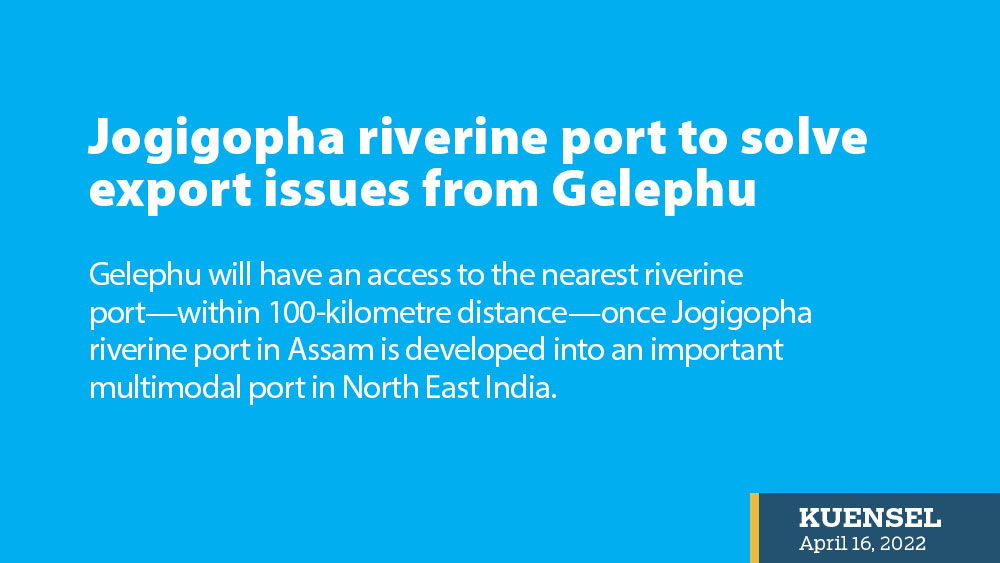Nima
Gelephu will have an access to the nearest riverine port—within 100-kilometre distance—once Jogigopha riverine port in Assam is developed into an important multimodal port in North East India.
The inland waterways conclave held from April 11 to 12 in Assam this week highlighted the multimodal port in Jogigopha as an important infrastructure to enhance regional connectivity through waterways; it is expected to fasten the bilateral trade between Bhutan, Bangladesh, and India.
Addressing the waterways conclave 2022 in Dibrugarh, Assam, Economic Affairs Minister Loknath Sharma said that the Northeast and Assam were the major trading hubs of Bhutanese for a very long time.
“Trade between Bhutan and India is increasing and will continue to so. Let us work towards enhancing the link between Assam and eastern Bhutan that has a huge potential in terms of economy of scale,” he said. The minister added that leveraging waterways is the answer.
The trade between Bhutan and India was recorded at Nu 94.89 billion in 2020, 82 percent of the volume.
“For the last three years, I have been talking about these links: Pandu, Jogigopha, Dubri, Chilmari, Narayanganj, and Mongla. It would be an achievement to sail through and see our connectivity potential within the region,” the Lyonpo said.
The Lyonpo added that the country has signed a memorandum of understanding with Bangladesh for the use of inland waterways through the Brahmaputra, entering the Chilmari port.
Currently, boulders from Gelephu are exported to Bangladesh and India by road. Boulder exports from Gelephu to Bangladesh require crossing three Indian states of Assam, West Bengal, and Meghalaya.
The export of riverbed materials has become a profitable venture today for Bhutanese exporters.
Gelephu Thrompon Tshering Norbu said that the port development at Jogigopha would bring immense benefits to Gelephu and also to the country.
“It would be the nearest riverine port to the country, about 91 kilometres away from Gelephu,” he said.
Tshering Norbu added that boulder trucks would not travel to Dubri, which are more than 140 kilometres away from Gelephu. “Truckers face many issues along the highway. There are many informal extortions. Importing raw materials would become much more convenient. We would also have an advantage on the cost of transportation.”
Raw materials and goods are imported from Kolkatta port today, more than 500 kilometres away from Phuentsholing.
Gelephu Thromde will soon finalise the drawing and designs for the integrated checkpoint that would bring import and export transactions under a single window, according to Tshering Norbu.
Boulders and aggregates were the most exported items to Bangladesh and India from Gelephu in 2020 and 2021, according to the record with the Sarpang dzongkhag administration. Even with restrictions during the lockdown in the past two years, Gelephu exported close to Nu 200 million worth of boulders and aggregates to India and Bangladesh.
Cardamom is the largest exported item from Gelephu with over Nu 600 million worth of cardamom exported to Bangladesh and India in 2020 and 2021, according to the record with the dzongkhag.
A businessman from Gelephu, Ugyen Rabten, said the port development at Jogigopha would benefit all forms of trade. “The riverine port is supposed to benefit Gelephu, particularly in terms of distance.”
Boulder exporters currently use Dubri port.
“There were issues of congestion and lack of stocking space at the port. Jogigopha would have ample space for all consignments,” said Ugyen Rabten.
“The current cost of transporting boulders on a 10-wheeler truck from Gelephu to Bangladesh is about Nu 42,000 with added Nu 7,000 on incidental expenses. The exporters have to bear additional detention charges of Nu 1,500 per day per truck,” according to CUTS, A kokata-based thinktank. “It is estimated that the use of an inland waterways route to Bangladesh would reduce the transportation cost by at least 30 percent compared to surface transportation due to the advantage of carrying a large volume of cargo at one go.”
Inland waterways are considered cheaper, environment-friendly, and hassle-free. The same waterways could be used for import, which otherwise uses land transport and increases the cost of goods, according to the report.
The study was conducted with the support from the Asian Development Bank and Bhutan Media and Communication Institute in December last year.
Exporter, Chencho Gyeltshen, from Gelephu, said the exporters were told that the port would be open for trade. “But, there is not much infrastructure development as of now. I think it will take time. For now, we have to use Dubri port.”
Sources said that the Jogigopha is an approved river port within 100 KM from Gelephu. But the port has not been notified yet for formal trade.
“Dubri port has only one placement of vessel. Exporters are not able to load from Jogigopha as yet,” a Gelephu businessman said.
Challenges and opportunities
According to the CUTS international report, Gelpehu offers a relative advantage and could connect to National Waterway 2 of India, road connectivity to the Asian Highway network; it is within 90 KM from the new multimodal terminal being developed in Jogigopha.
However, Gelephu lacks inter-modal infrastructure and rail connectivity; food and grain storage facilities; a common security checkpoint; an integrated check post; and the domestic airport need upgradation, according to the report.
At the waterways conclave, the officials from Bhutan suggested locations to facilitate a multimodal logistic supply chain through waterways in the region
The Government of India approved the trade route through Jogigopha in 2020. The first phase of the port development at Jogigopha is expected to complete in 2023.


